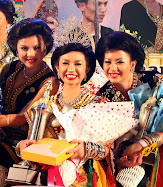The phrase is French for "deadly woman."
A femme fatale tries to achieve her hidden purpose by using feminine wiles and assets such as beauty, charm, and sexual allure.
Typically, she is exceptionally well-endowed with these qualities.
In some situations, she uses lying or coercion rather than charm.
The Lady from Shanghai (a 1948 film) giving one such example.
Her characteristic weapon, if needed, is frequently poison, which also serves as a metaphor for her charms.
The femme fatale archetype exists, in one form or another, in the folklore and myth of nearly every culture in every century.
The early examples are Ishtar, the Sumerian goddess, Eve, Lilith, Delilah, and Salome from the Judaeo-Christian Bible.
Beside them is the historical figure Cleopatra, The Queen of Egypt, with her ability to seduce the powerful men of Rome.
Roman propaganda attacked Cleopatra as a femme fatale; resultingly, she became the legendary archetype of the attractions and the dangers inherent to the powerful, exotic woman.
Perhaps the most famous modern era femme fatale was Mata Hari who died in 1917.
Mata Hari, a beautiful and alluring oriental dancer was accused of German espionage during World War I and was put to death by a French firing squad.
As such, she embodied the femme fatale archetype, and, after her death she became the subject of much fantastical imagining and the subject of many sensational films and books.
In real life, femme fatales are not that beautiful, but rather ordinary citizens, wives and mothers but with deadly motives.
In Iraq, female suicide bombers disguised themselves by wearing the traditional flowing robes to hide bomb-rigged belts or vests.
Female suicide bombers are said to be more effective and difficult to be detected by the authority because they exploit the cultural standards that restrict male security forces from searching women.
Her code name was "The Mother of Believers" .
Since her arrest by security forces last January, she has given unusual firsthand descriptions of the possible workings behind attacks by women bombers.
She is suspected of recruiting more than 80 female suicide bombers willing to carry out attacks and had admitted masterminding 28 bombings in different areas in Iraq.
In 2008, female suicide bombers attempted or successfully carried out 32 attacks around Iraq, compared with 8 attacks in 2007, according to U.S. military figures.
In January, a woman detonated an explosive under her robes, killing at least 36 people during a Shiite religious gathering.
In Sri Lanka, female suicide bombers are better known as the Black Tigers.
Prabakharan’s femme fatales are deadly, their attacks led to thousands of death.
A day before carrying out their missions, the elite Black Tigers are invited to a special dinner or the last meal - with Prabakharan.
Their missions - to kill or be killed no matter the attacks are successful or not.
When carrying suicide missions, these female bombers wear a cyanide vial.
If captured, they commit suicide by swallowing the cyanide, to evade interrogation.
The elite Black Tigers, launched its first suicide attack against a Sri Lanka Army camp, killing 40 soldiers in 1987.
It was said to be the first ever suicide bomber attack in the world.
Hamas drew inspiration from the LTTE attack and carried out its own suicide bombing in Israel.
Todate, the LTTE have carried out more suicide bombings than Hamas, Islamic Jihad and Al-Qaeda combined.
Perhaps the most high profile attack by the Black Tigers was in 1991.
A female suicide bomber reportedly sent by Prabakharan killed Indian Prime Minister Rajiv Gandhi at an election rally in India.
Then in November 2007, a chilling security camera footage captured a female suicide bomber on a mission to kill Sri Lankan Social Services Minister Douglas Devananda in Colombo.
The video, gave a rare look at a suicide bomber's last moments and the immediate aftermath of a devastating attack.
In the footage, the woman was seen patiently answering questions in a bustling government office before calmly standing up and detonated the bomb hidden in her bra.
On the day of the incident, the female bomber, wearing a yellow sari and a white shawl, calmly walked into a small waiting room at the Colombo offices of Devananda, the day he sets aside to hear complaints from the public.
The woman, identified as 24-year-old Sujatha Vagawanam, sat down in front of a desk and answered questions from Devananda's 72-year-old aide Steven Peiris.
As the two spoke, Peiris was repeatedly interrupted by other officials sitting nearby or walking past.
After nearly a minute and a half, he began gesturing for her to sit down in a nearby cluster of white plastic chairs, apparently to await a security check.
She then stood up facing Peiris, reached her right hand to her right shoulder to grab something and exploded.
Peiris and the bomber, both of whom were killed, flew backward.
The others in the room scrambled in all directions, some falling over their chairs in their haste to escape as a cloud of smoke hung in the air.
"She thought she was getting caught, so she exploded her bomb," said Devananda, who escaped the attack.
The LTTE is currently engaged in fierce fighting with the Sri Lankan troops.
Today the Sri Lankan forces claimed they have found Prabakharan fully furnished luxury residence complete with an apartment unit, 15 metres underground, North of Visuamadu.
Vellupillai Prabakharan is nowhere to be seen.

















































No comments:
Post a Comment